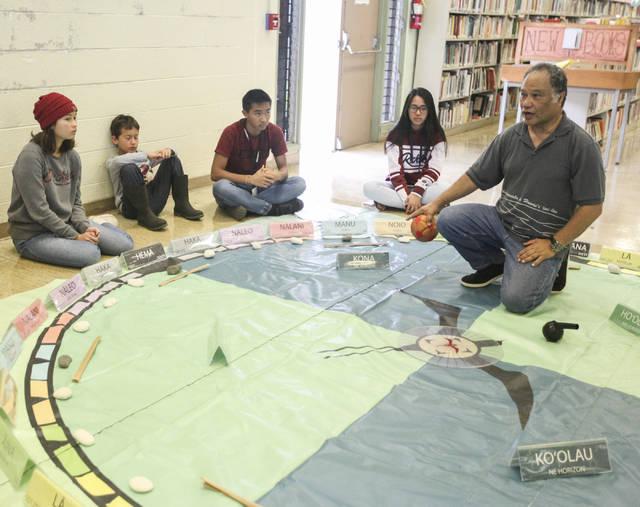‘Imiloa, UH-Hilo work to build wayfinding program


The resurgence of traditional wayfinding techniques began more than four decades ago and they are now finding their way into classrooms, the community and college curriculum thanks to the Imiloa Astronomy Center, a science education center thats part of the University of Hawaii at Hilo.
The resurgence of traditional wayfinding techniques began more than four decades ago and they are now finding their way into classrooms, the community and college curriculum thanks to the ‘Imiloa Astronomy Center, a science education center that’s part of the University of Hawaii at Hilo.
In 1975, the launch of Hokule‘a, the double-hulled sailing canoe like those used in original Polynesian navigation, “started this movement,” ‘Imiloa’s Navigator-in-Residence Kalepa Baybayan said.
ADVERTISING
One of the goals of that voyage was to use the traditional system of non-instrument navigation. But when Hokule‘a was launched, Baybayan said there were no Hawaiian navigators, “in fact, there were no navigators in Polynesia.”
Instead, crews learned of navigators in the Caroline Islands in Micronesia who were still practicing traditional methods of wayfinding.
Since then, Baybayan said “we’ve been kind of on this journey of learning about the art, and more recently we’ve been looking at how we can institutionalize it and how we can create curriculum that both relies on the traditional aspects of wayfinding, as well as the math and science that’s embedded in the art.”
According to information provided by ‘Imiloa Executive Director Ka‘iu Kimura, the development of a wayfinding education program at UH-Hilo, which would be based out of ‘Imiloa, will integrate Hawaiian perspectives and modern science through curriculum and placed-based learning that will include credit, non-credit and community education components.
‘Imiloa had sponsored a temporary position of master navigator for the Malama Honua Worldwide voyage and is now seeking to establish a permanent program that provides formal academic training and community education in celestial navigation and wayfinding.
But as a part of UH-Hilo, ‘Imiloa already has been collaborating with the university to build the wayfinding program.
The Ka Haka ‘Ula O Ke‘elikolani College of Hawaiian Language had previously offered navigation curriculum as a formal class, and when building ‘Imiloa, that curriculum was expanded to the astronomy center, which has continued to use and grow that program, Kimura said.
The School of Education has also started to partner with ‘Imiloa to have wayfinding be a part of the curriculum for current undergraduates as well as for professional development, she said.
As part of that effort, Baybayan said he has done two short presentations for students so far.
‘Imiloa also has offered outreach programs for about 12 years, but its current wayfinding outreach program, MANU (Modern and Ancient Ways of Navigating our Universe) ‘Imiloa, was launched in 2015.
“Our outreach effort is offered as an extension of UH-Hilo’s educational effort,” Baybayan said. “So we go out in the community and we engage schools from all levels of learning audience.”
“It is to augment the education that UH-Hilo currently offers and also the education the (state Department of Education) offers to the schools, ” said Yu Yok Pearring, ‘Imiloa’s director of marketing.
Part of the outreach to public schools includes the use of a portable dome to teach the celestial navigation techniques, experiences and history.
“So that sort of helps bring science to life, to further engage the interests of these kids in the world of science,” said Pearring.
That also includes work with the star compass.
“So we lay out our mat and put the stones around, and we tell them how the circle of stones represents the visual horizon and how as an islander, you need to create a device for orientation,” Baybayan said.
Through the circle of stones, students are told how celestial bodies move from one horizon and across the sky, he explained.
Once students have an introduction to the star compass, they’re taken into the dome.
“It’s a very high end portable planetarium that allows them to actually see digitally what the night sky looks like, so they can view the night sky during the day,” Baybayan said.
While ‘Imiloa currently delivers outreach programming to public and private schools, educators and community organizations, Baybayan said the next step in growing the wayfinding program is to introduce instruction “modules” at the university level.
That means they wouldn’t “teach the whole course, but maybe we could team up.”
For instance, Baybayan explained, if there’s a class in Hawaiian history, ‘Imiloa could teach two weeks of the section if it pertained to navigation or wayfinding.
However, Baybayban said he has only had conversations about introducing those modules, and nothing has formally been proposed.
“It is all tied to whether the positions for the wayfinding program become funded by the Legislature,” he said.
A bill currently before the state Legislature seeks funding for two full-time positions for the wayfinding program: navigator-in-residence — who would develop and implement navigation and wayfinding programs, including those for-credit and community outreach education, among other tasks — and education specialist, who will assist the navigator-in-residence in delivering and evaluating programs.
By early March, a draft of the legislation, with no specific appropriation amounts included, had passed through the state Senate and first reading in the state House.
Email Stephanie Salmons at ssalmons@hawaiitribune-herald.com.


